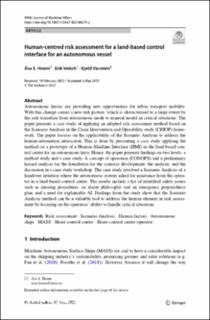| dc.contributor.author | Hoem, Åsa Snilstveit | |
| dc.contributor.author | Veitch, Erik Aleksander | |
| dc.contributor.author | Vasstein, Kjetil | |
| dc.date.accessioned | 2022-12-13T08:24:11Z | |
| dc.date.available | 2022-12-13T08:24:11Z | |
| dc.date.created | 2022-06-17T09:32:54Z | |
| dc.date.issued | 2022 | |
| dc.identifier.issn | 1651-436X | |
| dc.identifier.uri | https://hdl.handle.net/11250/3037378 | |
| dc.description.abstract | Autonomous ferries are providing new opportunities for urban transport mobility. With this change comes a new risk picture, which is characterised to a large extent by the safe transition from autonomous mode to manual model in critical situations. The paper presents a case study of applying an adapted risk assessment method based on the Scenario Analysis in the Crisis Intervention and Operability study (CRIOP) framework. The paper focuses on the applicability of the Scenario Analysis to address the human-automation interaction. This is done by presenting a case study applying the method on a prototype of a Human–Machine Interface (HMI) in the land-based control centre for an autonomous ferry. Hence, the paper presents findings on two levels: a method study and a case study. A concept of operation (CONOPS) and a preliminary hazard analysis lay the foundation for the scenario development, the analysis, and the discussion in a case study workshop. The case study involved a Scenario Analysis of a handover situation where the autonomous system asked for assistance from the operator in a land-based control centre. The results include a list of identified safety issues such as missing procedures, an alarm philosophy and an emergency preparedness plan, and a need for explainable AI. Findings from the study show that the Scenario Analysis method can be a valuable tool to address the human element in risk assessment by focusing on the operators’ ability to handle critical situations. | en_US |
| dc.language.iso | eng | en_US |
| dc.publisher | Springer Nature | en_US |
| dc.rights | Navngivelse 4.0 Internasjonal | * |
| dc.rights.uri | http://creativecommons.org/licenses/by/4.0/deed.no | * |
| dc.title | Human‑centred risk assessment for a land‑based control interface for an autonomous vessel | en_US |
| dc.title.alternative | Human‑centred risk assessment for a land‑based control interface for an autonomous vessel | en_US |
| dc.type | Peer reviewed | en_US |
| dc.type | Journal article | en_US |
| dc.description.version | publishedVersion | en_US |
| dc.source.pagenumber | 179–211 | en_US |
| dc.source.volume | 21 | en_US |
| dc.source.journal | WMU Journal of Maritime Affairs (JoMA) | en_US |
| dc.identifier.doi | 10.1007/s13437-022-00278-y | |
| dc.identifier.cristin | 2032731 | |
| cristin.ispublished | true | |
| cristin.fulltext | original | |
| cristin.qualitycode | 1 | |

